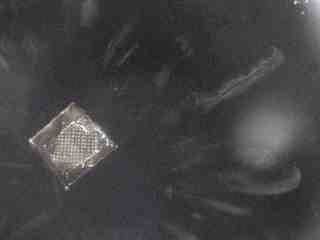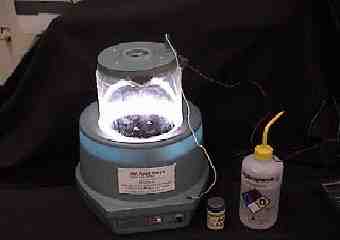Here we explain how to set up and use a cloud chamber to see nuclear decay particles.
Watch Video:
- Nuclear Decay
- Radiation
- Magnetic Lorentz Forces
A cloud chamber is a sealed chamber that contains a supersaturated vapor of water, alcohol, or other compound that can be kept near its condensation point by regulating the temperature of the chamber. When ionizing radiation passes through the supersaturated vapor in the chamber, it leaves a trail of charged particles (ions) that serve as condensation centers for the vapor, which condenses around them. The path of the radiation is thereby indicated by tracks of tiny liquid droplets in the supersaturated vapor.
For this demonstration we used a diffusion cloud chamber. A diffusion cloud chamber maintains a large temperature difference between the top and bottom of the chamber, usually by cooling the bottom of the chamber with dry ice. The gas in the chamber, usually air, is saturated with a vapor, usually alcohol (methanol or isopropanol work well); the air-vapor mixture cools as it diffuses toward the cool bottom, becoming supersaturated. The alcohol saturation of the air is maintained by the prescence of an alcohol-soaked pad inside the top of the chamber.
 Figure 1: Snap-shot of alpha chamber contrails |
 Figure 2: Dispersion of contrails 1/10s later |
The image on the left shows a strong alpha track at the upper right of the image. The image on the right was taken 1/10 of a second later showing the same alpha track. However, now the track is starting to disperse and to show a distinct line running up the middle of the track.
An alpha particle is a positively charged Helium-4 nucleus that is comprised of two neutrons and two protons. Alpha particles are ejected from unstable larger nuclei through radioactive decay. It is the least-penetrating of the three common forms of radiation, and can be stopped by a sheet of paper or by the cloth in the clothes that you are wearing. It is not dangerous to living things unless the alpha-emitting substance is inhaled, ingested, or comes into contact with the lens of the eye.
Apparatus:
- A cloud chamber
- An Americium-241 sample (or another source of alpha particles)
- Isopropanol
- Dry ice
Procedure:
- Remove glass cloud chamber from its base, then pack dry ice into the base of the cloud chamber and return the glass chamber to the top.
- Make sure the base plate of the chamber is in contact with the dry ice and the grounding contact on the side of the base.
- Fill the trough around the edge of the base plate with isopropanol, and saturate the sponge on the lid with isopropanol.
- Place alpha source in the cloud chamber (close to the middle works best).
- Place the lid on the chamber and turn on the built-in high voltage supply and chamber light. Now wait...

Figure 3: Cloud Chamber
After a while, the chamber's atmosphere reaches a supersaturated alcohol vapor equilibrium where any little disturbance causes the alcohol that is suspended to condense forming alcohol droplets (clouds). This may take anywhere from 5 min to an hour, so it is best to set this demo up well in advance of viewing time.
Tips:
- Set up the chamber 30 minutes before intended viewing, to allow for equilibrium to be established.
- You must have a supersaturated alcohol vapor. Make sure the sponge on the lid is saturated with alcohol and that there is puddling of alcohol on the bottom of the chamber.
- To rapidly cool the chamber, pile dry ice around the outside perimeter.
- This is a "finniky" demonstration. It can take up to an hour to produce the right environment to see the alpha tracks.



